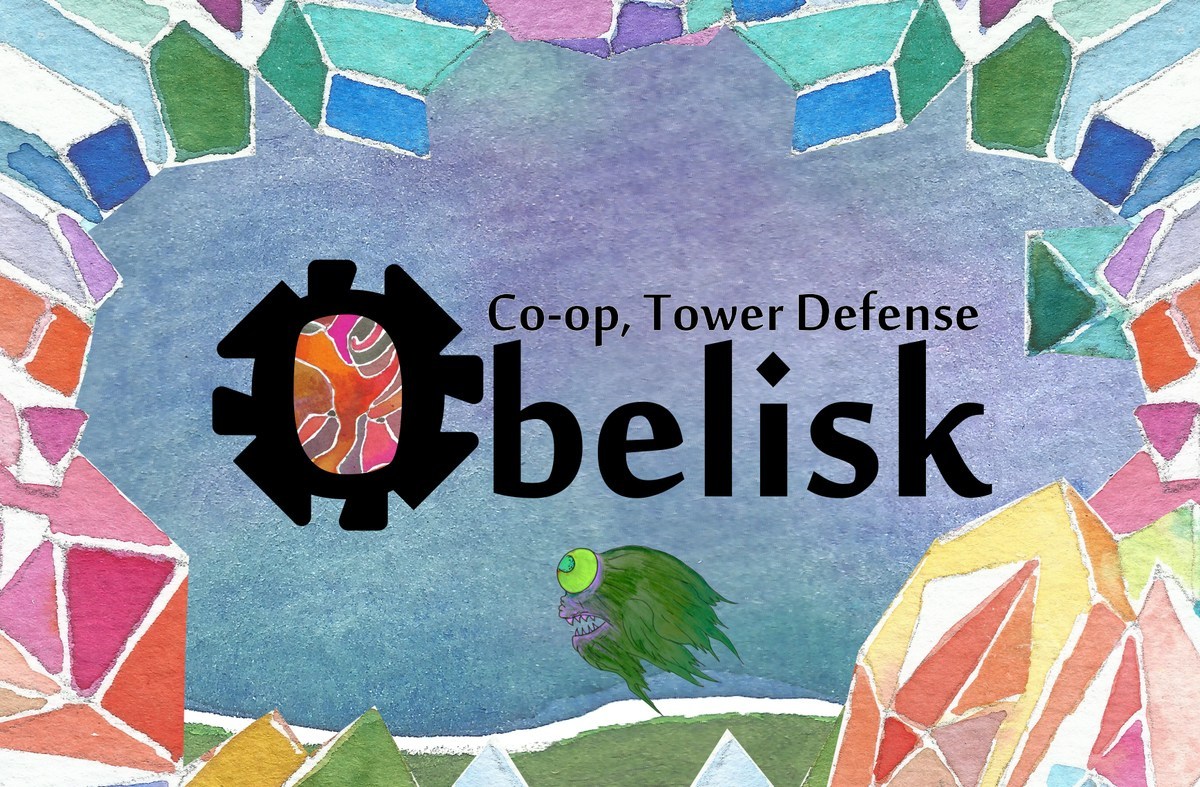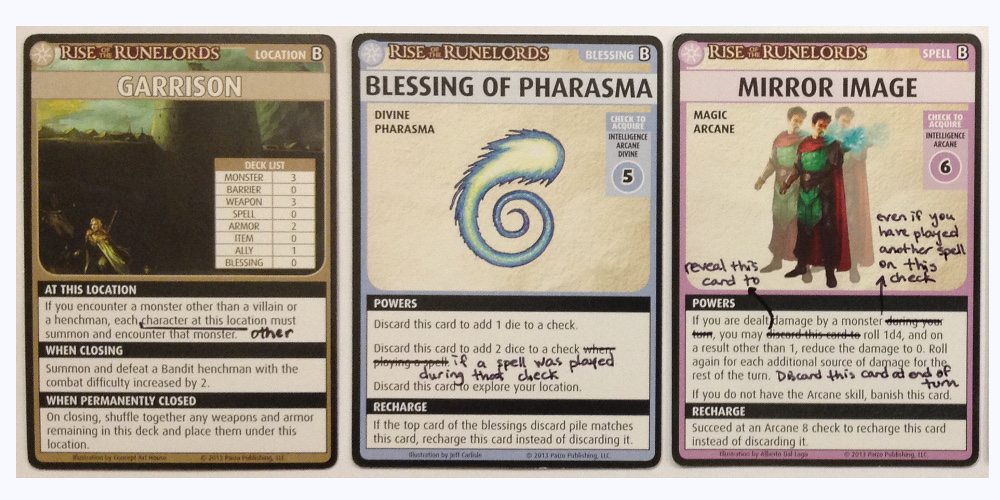Stone demons are pouring out of the portal! Build obelisks to capture them before they escape in this compact tower defense game.
What Is Obelisk?
Obelisk is a cooperative tower defense game for 1 to 4 players, ages 12 and up, and takes about 20–30 minutes to play. It’s published by Tessellation Games via The Game Crafter, and there’s a Crowd Sale this coming week (April 15–22). The normal price for Obelisk is $24.99, but will be $19.99 (or as low as $14.99) during the Crowd Sale.
Not familiar with The Game Crafter’s Crowd Sale concept? Read about it here.

Obelisk Components
Note: My review is based on an earlier version; some of the artwork has changed from the version you’ll see in my photos.
Here’s what comes in the box:
- 25 Map cards
- 1 Portal
- 4 Crystals
- 10 Forests
- 6 Grass
- 4 Mountains
- Quarry card
- 11 Obelisks (dice)
- 3 Blue
- 3 Yellow
- 3 Green
- 2 Black
- 22 Rotation markers
- 50 Stone Demons
- 14 Yellow
- 18 Green
- 18 Blue
- 10 Player Guide cards
- 4 Turn Guide cards
- 8 Scroll cards
- Dark Realm (box bottom)
- Supply (box lid)

The game comes in a small two-piece box, which also serves as the “Dark Realm” and “Supply.” All of the cards, from the map tiles to the player aids, are small square cards. The map tiles feature watercolor illustrations by Anca Hariton and are a little impressionistic, which is a fun change from most games and a little unexpected for a game that’s about monsters rampaging across a landscape, but I like it.
The other components are fairly simple: small transparent plastic cubes for the monsters, little clear chips for the rotation markers, and some six-sided dice. I do wish that the monster colors and dice colors did not overlap—as in most games, it can be confusing when player colors overlap with resources or other components but there’s no actual connection between the two. Also, it may seem odd that there are only 2 black dice and 3 each of the others—in actuality, it wouldn’t really matter if all the dice were the same color because it’s a fully cooperative game and you just get a certain number of dice per player. It just happens that the black dice are only used in a 4-player game, in which case each player only gets 2 dice.

There are also optional tiles for the stone demons, in case you’d prefer something with illustrations on it or if you have trouble distinguishing the colors of the cubes. They’re small square tiles, illustrated on one side. You can add them to your order here.
Overall, I think the component quality isn’t quite as polished as most traditionally published games and is more like a lot of the Kickstarter prototypes I see—not surprising since many publishers use The Game Crafter as a way to create their prototypes. At the same time, the quality of prototypes (and different components available from The Game Crafter) has improved over the years, so it’s not bad, either.
How to Play Obelisk
You can download a copy of the rulebook here.
The Goal
The goal of the game is to capture all of the stone demons before any of them escape.

Setup
Shuffle the map cards and lay them out in a 5×5 grid, being sure to randomize both the order and the orientation of the cards. Once laid out, remove the 4 mountain cards, leaving gaps. Place a rotation marker on each card.
Create the pool of stone demons according to the setup card, placing them in the Dark Realm. Basically, you’ll have 36 stone demons total, a mix of the three colors based on the difficulty level. The rest of the stone demons are placed in the supply. Set the quarry card nearby—depending on the number of players, you may draw some random stone demons from the supply and place them on this card.

Each player gets a player aid card according to the player count—the player aid card tells you how many actions you get per turn, how many dice you start with, and the various actions available to you.
Gameplay
During the Day phase, players will take actions to build and upgrade obelisks, mine for stone, or rotate tiles. During the Night phase, the stone demons spawn from the portal and march across the map.

Players may take turns in any order, and the number of actions you get each turn is shown on your player aid card. To build an obelisk, you simply place one of your dice (with the value set to 1) on a free intersection: the obelisk covers the four cards that it’s next to.
You can mine for stones—take a green cube from the supply and place it on your quarry. (The stone demons turn into stones when caught by sunlight, and you use them to upgrade your obelisks.)
To upgrade an obelisk, you must spend 4 green, 3 yellow, or 2 blue monsters. (Blue monsters are wild and can also be used in combination with the other colors.) Discard the required monsters from the quarry card into the supply, and then increase the value of a die on the map. You may also upgrade an obelisk by discarding one of your unbuilt dice into the supply.
Finally, you can rotate tiles to direct the monsters along a particular route. When you rotate a tile, you may rotate it to any orientation, but each tile may only be rotated once during the game! After rotating it, remove the rotation marker.

During the Night phase, the stone demons come out of the portal. Draw 6 cubes at random from the Dark Realm, and place them on the portal. Then, they start to move. Green monsters move 4 spaces, yellow monsters move 3 spaces, and blue monsters move 2 spaces, following the trail markers on the map cards.

Along the way, if they pass through a space with an obelisk on the corner, the obelisk can capture the monster. The obelisk must meet or exceed the monster’s strength: green monsters have 1 strength, yellow monsters have 3 strength, and blue monsters have 5 strength. In addition, some of the map cards make the obelisk less effective: a forest subtracts one from an obelisk’s strength, and crystals subtract 2. In those cases, the obelisk must be even stronger in order to capture a monster.
Each obelisk may only capture one monster per Night. The monster is placed on top of the obelisk to show that the obelisk has already been used.
Once all of the monsters have marched, the captured monsters are placed onto the quarry card, and then the next Day phase begins.
Game End
The game ends in two ways: if any monster ever moves off the map, or if a monster ever steps on a card that it has been through already, then you lose.
If you capture all of the monsters, then you win.

There’s also an advanced variant that adds scrolls. In this version, you leave the mountains on the map. Monsters still may not travel onto the mountains, but some of the scrolls may be used on obelisks bordering mountains.
Add 2 more of each monster into the Dark Realm, and make a stack of 6 randomly chosen scroll cards, face-down. Set the “Broken Earth” scroll card face-up near the stack.
During each Day phase, reveal the next scroll card in the stack. You may use the upgrade action to install these scrolls under existing obelisks (paying the usual upgrade costs). The background shows which terrains must be adjacent to the obelisk in order to install the upgrade. The scrolls have various effects: capture more monsters per turn, randomize your obelisk’s strength, and even move map tiles around.
On each Night phase, you spawn 7 monsters instead of 6. The rest of the game is the same.
Why You Should Play Obelisk
With the popularity of digital tower defense games, it’s no surprise that tabletop game designers are trying to tackle the genre, too. Some simplify the monster paths by simply having monsters be a certain distance away from your tower, and your goal is to kill them off before they knock down your tower. Others try to replicate the way that monsters travel along paths, taking damage as they walk past your towers—but in most cases that I’ve seen so far, this involves a lot of upkeep as you move monsters, check for damage, and so on. It can be a lot of fun playing a tower defense game on the tabletop, but manually resolving effects that are usually automatically taken care of by a computer can be tedious and time-consuming.
Obelisk caught my attention because it’s a cooperative tower defense game with monster paths that advertised a play time of half an hour. I was really curious how that was possible, but I can confirm that a game of Obelisk does play pretty quickly. Some of that is because of the way the towers and monsters are both simplified. All of the towers have the same range (the four cards they’re touching), a strength, and are limited to one monster per turn. There are only three types of monsters—the faster it moves, the weaker it is. As soon as each tower has captured one monster, then you just move all the rest of the monsters, and the night phase is over. Done!
The monster-spawning is also much simpler: you just pull six cubes out of the box and place them on the portal. The player turns are also quick, because your actions are limited, both in number and in scope. All of that adds up to a game that keeps some aspects of tower defense games like directing monsters along a path and upgrading towers to handle stronger monsters, while cutting down the upkeep time for tabletop purposes.

Okay, so it’s quick. But is it fun? Is it challenging?
For me, those two questions are connected: a cooperative game has to present at least some challenge, or it becomes boring. Too challenging, and it gets discouraging. Obelisk feels like the difficulty level can be somewhat swingy: I’ve played some games where it seemed like it was going to be impossible from the start, and some where it seemed like a matter of just letting everything play out. The two main factors in that random chance are the board layout and the monsters that are drawn each night.
Depending on where the mountains wind up, you may not be able to draw a single continuous path that covers all of the terrain. Chances are, you’ll just end up bypassing a few cards here and there. If those cards happen to be crystals, well, those are harder to capture monsters on anyway. But if they’re grass cards, then you’ve lost access to one important space where you might be able to catch a monster with a weaker tower.
If you draw a pile of blue monsters at the beginning of the game, you can really feel stuck. They’re slow, so you have some time, but it means that you’re not capturing the green monsters that you can pick off with level 1 obelisks. And because you haven’t captured anything, then you don’t have the resources to spend to upgrade your towers so that you can go after the blue monsters. A couple of bad draws near the beginning of the game can really make it impossible, even if you do everything else right. In most tower defense videogames, you get easier monsters up front so that you’re more likely to survive them, and then you earn money, which upgrades your towers in time for the harder waves. In Obelisk, the difficulty level determines the overall mix of monsters, but not the order in which they arrive.
That said, I do like the puzzle of figuring out what path to set for the monsters, where to place the towers to have the best coverage, and how to spend our precious few actions each day to prepare for the night. One of the biggest challenges is knowing when it’s appropriate to spend a die to upgrade a tower. Sometimes you don’t have time to wait until you capture (or mine) enough monsters to afford an upgrade, but spending a die means one fewer tower you’ll have. On the other hand, at some point, you’ll need enough strong towers to deal with the blue monsters, because having a lot of weak towers won’t do any good.
The nature of the game does mean that if you’ve got an alpha player they can take over the direction of the game and tell people what to do since there’s no hidden information between players. If your gaming group is susceptible to that, then you probably need to figure out ways to ensure that each player gets to make their own choices—and that may be true for other games as well.
The scrolls add another layer of possibilities, and I like the way that they make the towers more individualized. Using the scrolls means that you add more monsters to the pool and draw 7 each day instead of 6, but I think the trade-off is worth it (even with the additional sources of chance) because it does make the game a bit more dynamic. You start each game with the Broken Earth scroll, which allows you to rearrange the map around an obelisk, so that might help you reconnect those map tiles that would otherwise be orphaned and wasted. But then each subsequent round you’ll get access to another random scroll, and you can decide whether it’s worth the upgrade to use them.
The Crystal Network boosts a tower’s strength on crystals, and also lets you capture from any crystal space—but you still have to overcome the natural weakening that occurs from the crystals. Instability makes you re-roll the die each round, so you never know what strength to expect—but it also means you might have a 6-strength tower if you roll well. I like the Lightning Rod, which increases your obelisk’s capacity for capturing monsters—extremely useful if there’s a clump of monsters coming at once. (And, let’s face it, there usually is.)
The other significant feature of Obelisk is its small size and price, particularly compared to other tower defense games I’ve seen so far. It may not have the attention-grabbing draw of a sprawling game, but it’s pretty cool to have a tower defense game that fits in your pocket: the box is even smaller than the Tiny Epic series.
Overall, I think Obelisk would be a good fit for those wanting a streamlined tower defense experience. It doesn’t include a lot of special abilities or unique monsters, but it’s a game that you can set up and get going without too much preparation. For those who are curious, this week’s Crowd Sale gives you a chance to save a few bucks, too.
For more information or to make a pledge, visit the Obelisk Crowd Sale page!
Click here to see all our tabletop game reviews.
![]() To subscribe to GeekDad’s tabletop gaming coverage, please copy this link and add it to your RSS reader.
To subscribe to GeekDad’s tabletop gaming coverage, please copy this link and add it to your RSS reader.
Disclosure: GeekDad received a copy of this game for review purposes.






